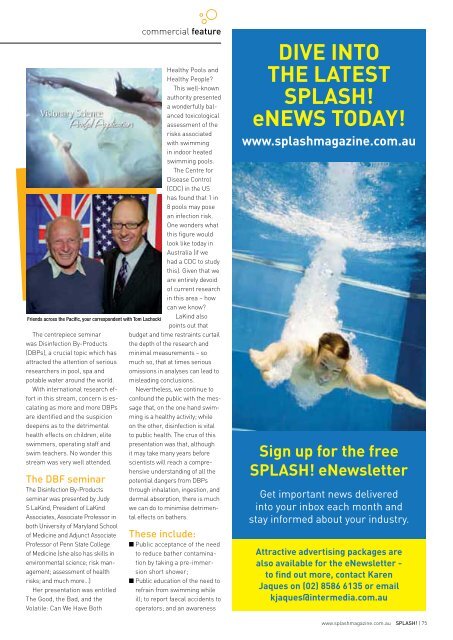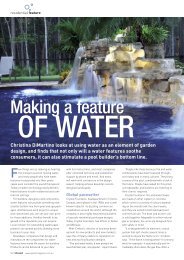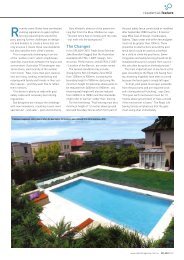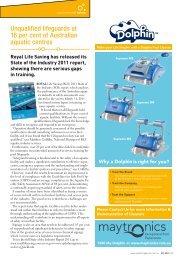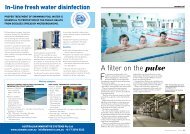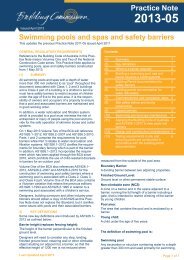Splash73p58-92 - Splash Magazine
Splash73p58-92 - Splash Magazine
Splash73p58-92 - Splash Magazine
Create successful ePaper yourself
Turn your PDF publications into a flip-book with our unique Google optimized e-Paper software.
Friends across the Pacific, your correspondent with Tom Lachocki<br />
The centrepiece seminar<br />
was Disinfection By-Products<br />
(DBPs), a crucial topic which has<br />
attracted the attention of serious<br />
researchers in pool, spa and<br />
potable water around the world.<br />
With international research effort<br />
in this stream, concern is escalating<br />
as more and more DBPs<br />
are identified and the suspicion<br />
deepens as to the detrimental<br />
health effects on children, elite<br />
swimmers, operating staff and<br />
swim teachers. No wonder this<br />
stream was very well attended.<br />
The DBF seminar<br />
The Disinfection By-Products<br />
seminar was presented by Judy<br />
S LaKind, President of LaKind<br />
Associates, Associate Professor in<br />
both University of Maryland School<br />
of Medicine and Adjunct Associate<br />
Professor of Penn State College<br />
of Medicine (she also has skills in<br />
environmental science; risk management;<br />
assessment of health<br />
risks; and much more...)<br />
Her presentation was entitled<br />
The Good, the Bad, and the<br />
Volatile: Can We Have Both<br />
commercial feature<br />
Healthy Pools and<br />
Healthy People?<br />
This well-known<br />
authority presented<br />
a wonderfully balanced<br />
toxicological<br />
assessment of the<br />
risks associated<br />
with swimming<br />
in indoor heated<br />
swimming pools.<br />
The Centre for<br />
Disease Control<br />
(CDC) in the US<br />
has found that 1 in<br />
8 pools may pose<br />
an infection risk.<br />
One wonders what<br />
this figure would<br />
look like today in<br />
Australia (if we<br />
had a CDC to study<br />
this). Given that we<br />
are entirely devoid<br />
of current research<br />
in this area – how<br />
can we know?<br />
LaKind also<br />
points out that<br />
budget and time restraints curtail<br />
the depth of the research and<br />
minimal measurements – so<br />
much so, that at times serious<br />
omissions in analyses can lead to<br />
misleading conclusions.<br />
Nevertheless, we continue to<br />
confound the public with the message<br />
that, on the one hand swimming<br />
is a healthy activity; while<br />
on the other, disinfection is vital<br />
to public health. The crux of this<br />
presentation was that, although<br />
it may take many years before<br />
scientists will reach a comprehensive<br />
understanding of all the<br />
potential dangers from DBPs<br />
through inhalation, ingestion, and<br />
dermal absorption, there is much<br />
we can do to minimise detrimental<br />
effects on bathers.<br />
These include:<br />
n Public acceptance of the need<br />
to reduce bather contamination<br />
by taking a pre-immersion<br />
short shower;<br />
n Public education of the need to<br />
refrain from swimming while<br />
ill; to report faecal accidents to<br />
operators; and an awareness<br />
Dive into<br />
the latest<br />
splash!<br />
enews toDay!<br />
www.splashmagazine.com.au<br />
Sign up for the free<br />
SPLASH! eNewsletter<br />
Get important news delivered<br />
into your inbox each month and<br />
stay informed about your industry.<br />
Attractive advertising packages are<br />
also available for the eNewsletter -<br />
to find out more, contact Karen<br />
Jaques on (02) 8586 6135 or email<br />
kjaques@intermedia.com.au<br />
www.splashmagazine.com.au SPLASH! | 75


